“Strictly speaking, we haven’t started anything yet.” ~Vladimir Putin, July 2022
Since we’re getting so close to approaching the nail-biting period of February 21 - 24 that so many are anticipating, I figured it’ll be good to compile all the recent, top developments regarding the potential for a new ‘major’ Russian offensive. Some of them have already been mentioned in a previous update, but we’ll cite them again to centralize all relevant materials.
1. First, there are two reputable channels which are now confirming major actions are coming within a week. Romanov Lite, who many of you know, is a Crimean based commentator who also works with some Russian/Donbass units, helping supply them and is often seen on the lines with them, often has insider info as he speaks directly to the troops. He posted this message that it is soon GO TIME:
Note, the specific confirmation of something we predicted here in one of the recent reports, which is that the offensive is likely to kick off, not all at once but in several stages in order to maximize confusion, allow a little lead time for AFU to frantically send reserves to one direction to caulk the flow, only for a completely different direction to massively kick off into un-reinforced territory.
2. Then, another reputable channel issued this urgent call of alarm:
“From "2 Majors" TG Channel:
--
Residents of Ukraine
Everyone understands that the past month, during which the Russian Armed Forces seized the initiative, was a preparation . Open sources mention the Sumy, Chernigov, Kharkov and Zaporizhia as possible directions for an offensive.
People living in these territories can see for themselves signs of how the AFU are preparing these cities and areas for defense. The area is being mined, fortifications are being built, military columns and buses with mercenaries are moving.
The Ukrainian command has good intelligence from American satellites, processed by experienced analytical centers.
But official Kiev does not announce the evacuation of the population. Because fortified areas are being built in cities and the civilian population will once again become a human shield. Evacuation in Kupyansk was announced after the Russian Armed Forces approached the city at 7-10 km.
It is absolutely necessary for Ukrainians to leave these cities. The Russian Armed Forces will no longer conduct a police operation. Such nonsense as it was in Mariupol, when the position of an enemy sniper/machine gunner could not be demolished because in a dilapidated five-story building "there can be civilians", will no longer apply.
And after all the horrific videos of tortures and shootings of our soldiers, the joyful reaction of a large number of Ukrainians to them, the attitude of soldiers and officers to "peaceful population" has changed somewhat.”
3. Recently we had the first ever confirmation—with actual photographic evidence—of Russian force buildups on Ukraine’s border resembling those of pre-Feb. 2022. Here are satellite photos of one of them; there are reportedly such camps in Kursk and Voronezh regions, which are directly above Sumy and Kharkov oblasts of Ukraine.
4. There are now several reports of large field hospitals being constructed in at least two different regions, again reminiscent of exactly what happened last time prior to the start of the SMO. And a senior lieutenant of the AFU stated that 10,000 Russian troops have amassed across the border from Sumy.
Senior Lieutenant of the Armed Forces Andrey Gulakov for The Times
According to him, the invaders built a field hospital there, and this is an indicator that the Russians are planning offensive actions, as they did last year.
Interestingly, this is characterized as ‘the largest concentration that’s ever been there’, including in the buildup of last year. 10k doesn’t seem like a lot of troops. But it only goes to show the accuracy of our premise from the Part 1 report, which found that Russia used only a small fraction of the troops everyone thought they did. Last year’s Sumy incursion must have likewise been very small, a brigade or two in size (or rather, several BTG’s).
Also, you can see in the above post that Russians have reportedly laid gravel on the routes along the border, nullifying the rasputitsa problems.
Another report:
According to foreign intelligence, there is a tactical group of the Russian Armed Forces with a total of 26,800 people on the territory of Belarus. The group of forces is armed with 18 combat aircraft and 25 helicopters of various types, as well as 116 tanks, including T-90, and several hundred armored combat vehicles.
Additionally, enemy intelligence notes that we have deployed 6 Iskander missile launchers and 26 different types of MLRS. In the city of Grodno, a hospital base is deployed on the basis of the 1134th VCMC.
5. A massive 80km long convoy of Russian army supply trucks is reported to be currently in transit slowly through mud between Mariupol & Berdiansk, according to ‘advisor to the mayor of Mariupol’ Petro Andryuschenko. Keep in mind this is the exiled Ukrainian ‘ex-advisor’ to the previous Mariupol administration prior to its liberation.
Andryuschenko is the same one who reported last time that Russian troops have massively increased by ‘tens of thousands’ north of Mariupol, which was later specified as going from 10k to 30k troops.
6. Ukrainian MP Goncharenko claims that in far western Belarus, a group of ‘Wagner’ soldiers were spotted.
7. And buses reportedly full of 1700 Wagner soldiers are being sent toward Zaporozhe (one of the imminent lines of attack in the coming offensive):

However, some believe they could be headed to Ugledar, which would make more logical sense as Wagner fighters are known as urban combat specialists. And in the last few days, Russian Marines have finally entrenched themselves in the first urban settlements right at the outskirts of Ugledar, which could mean that Wagner is now being sent in to prepare for actual urban storming of said town.
8. Russian Buks and other AD is also seen moving from the Mariupol direction toward the likely offensive vectors:

9. Now, keep in mind there are also dissenting voices who claim that not only is no ‘large offensive’ coming any time soon, but that Russia is in fact ‘incapable’ of even launching any such offensive.
10. We reported the alleged numbers last time, but will collate it here again:
“The Russian Federation has prepared 1,800 tanks, 3,950 armored vehicles, 2,700 artillery systems, 810 Soviet-era self-propelled guns, such as Grad and Smerch, 400 fighter jets, and 300 helicopters for the upcoming massive attack on Ukraine . Foreign Policy writes about it .”
Specifically, in light of the 700-750 jets and helicopters, there are also rumors circulating on Ukrainian airwaves that Russian airforce will not only operate in a wholly new doctrine in the coming offensive, but have already been seen doing this recently.
"Previously, the aviation was protected, it almost did not fly into the zone of action of the Ukrainian air defense. Now they decided to change the tactics," says the interlocutor of the journalists. According to the journalist's source, the Russian Federation still has an advantage in aviation over the Armed Forces. Despite the fact that Russian planes and helicopters will be shot down en masse, this will create certain problems for the Ukrainian army."
The ‘new doctrine’ entails the usage of Russian airpower incursions much deeper into the heart of Ukrainian land, rather than skirting the edges of the contact lines for fear of being shot down, as they do now.
Ignore the angsty cope in the above tweet, it’s simply to reference the ‘rumors’ of the Russian MoD’s shift in strategy.
There are claims that in the past couple of weeks, Russian jets have already been doing this, as well as “new types of drones.” Not only have a few interesting videos turned up—one of them showing a Russian Su-24M flying over Kherson at an altitude high enough to suggest it had zero fear of AD (i.e. 3000-5000ft rather than the usual 100-300ft), but also a few days ago the AFU complained that some sort of new ‘long range’ and ‘high altitude’ set of drones were flying deep over their territory in the following route:
They said they flew at upwards of 18,000 - 20,000ft which is extremely high for most of the types of drones in this conflict. This coincided with a large Russian loitering drone strike only days later which was carried out by some “new type” of drone with a notably different sonic pattern than the famous Shahed/Geran/Dorito ‘lawnmower’ noise. These drones had a much ‘deeper’ motor sound suggestive of perhaps a larger or more powerful drone.
And this was at the head of reports that Iran had delivered several new types of “larger drones” to Russia, which we mentioned in a previous writeup, likely the Shahed-129 and more Mohajer-6’s as well as some claim maybe Shahed-171. Of course, it’s all speculation for now.
But the interesting thing about that flight pattern posted in an above graphic, which is straight from Ukrainian channels themselves, is that it shows a deep observation into the deepest rear areas of AFU. And on the eve of a potential large-scale military action, it suggests a probing and reconnaissance of AFU’s critical rear areas to prepare mass strikes on them in the coming days.
As per the new RuAF doctrine, there are reports such as the following:
Apparently, Russia has been utilizing far more direct precision (PGM) missile strikes onto Ukrainian positions. This has major significance for two reasons: firstly, long ago, Russian strikes were often in two main camps of short range ‘tactical’ level artillery of various sorts, and long range ‘strategic’ level cruise missile strikes onto critical infrastructure, launched by heavy bombers etc. But this represents a shift into vital medium range striking abilities, with Russian jets like Su-24m’s, Su-30, Su-34, etc., likely launching these newly ramped missiles onto tactical-level targets just in the rear of frontline units.

There are a variety of proofs to substantiate this. Not only have we seen several videos of Dmitry Medvedev touring Russian missile factories that produce exactly these munitions, in announcement of the vast ramping up of their productions (here and here).
But videos recently began to emerge reportedly showing Su-34’s more actively firing such medium range air-to-ground PGM’s into AFU positions (here and here).
And also were the repeated recent warnings of Russian forces employing “new tactics” such as air balloons with reflectors attached to confuse/expend Ukrainian AD, as well as increasingly more complex waves of dummy ‘decoy missiles’.
So, adding those things together, we can see that in the upcoming escalations, Russia will likely be employing their airforce (the totality of airpower, including new drones) in increasingly active ways to demolish a depleted Ukrainian army. One of the reasons it’s certain they’ll be doing this is because contrary to UA sources, the Ukrainian air defense network is close to nonexistent at this point.
One thing one must learn is that the MORE ridiculous the claims from UA, usually the MORE they’re overcompensating for the exact opposite. So the recent claims of 80-150% shootdowns of Russian missiles are in fact the opposite. A deep analysis has shown that Ukraine is shooting down next to nothing anymore. They have almost no AD left whatsoever, other than manpads. Most aren’t aware of just how few western systems they received. Their legacy S-300’s are down to almost nothing, and they only got a couple units of NASAMs and Iris-T, which are mostly all stationed in Kiev to protect the capital city.
People don’t realize just how many missile units one needs to adequately protect even a single city. For instance, just around Moscow alone, Russia has 12 battalions of S-400’s. A single battalion has 8 launchers with 32 missiles. 12 x 8 = 96 launchers of 384 missiles. And this is JUST the S-400 alone. There are NUMEROUS other layered/integrated SHORAD systems like Pantsirs, etc., stationed there as well (here and here).
So, total, there is likely hundreds of AD systems just for Moscow alone, representing thousands of total missile calculations (and same for St. Petersburg). Kiev on the other hand appears to have 2-4 NATO launchers total, with a few extra manpads sprinkled in, as well as short range mobile systems, like the recently spotted British Starstreak on the Alvis Stormer around Kiev.
In short, Ukraine’s AD network is in DIRE condition. And I believe this is the reason that Russian airforce is beginning to step up and operate with more impunity. And once even MORE fixed-wing/rotary pieces join the fray, it will create the compounding effects I spoke of last time, and should completely overpower the remaining AD and wreak havoc on the AFU. And this goes with the mentioned ‘rumors’ that the next phase will feature a much more offensively active RuAF.
And by the way, there is far more evidence of why the Ukrainian AD is heavily degraded to the point of nonexistence, but I feel it’s beyond the scope of this simple Sitrep and don’t want to get into every single point—but just know that this part is not mere speculation, it’s based on heavy, accurate longstanding analysis with much corroborative facts which include the direct statements of several RuAF pilots in interviews posted to the Russian MoD channel, where they directly state this.
Am I saying that UA has no way to defend against air attacks at all? No, of course not, they still have plenty manpads (although I do believe they’re not as numerous as before), and if a massive concerted Russian Airforce effort is launched, there WILL of course be an uptick in casualties and shoot downs—that’s simply and unfortunately the way of war. But the question is, will the trade off be worth it? If our forecast in how degraded the UA AD is, is accurate, then it likely will be more than worth the trade as RuAF will be delivering newly produced PGM’s in ways never seen before which will greatly compound the devastating effects of the ground force pushes.
11. Putin met Lukashenko in Moscow yesterday. Such in person meetings between important people often occur on the eve of something momentous, as likely they need to speak in private about the final logistical details and preparations vis a vis any Russian forces that may potentially be moving in/from/around Belarus—or other sundry Belarusian participation, be it logistical or otherwise.
12. The large reported die-down of both Russian artillery and long range missile strikes (they still happen, just not as often—at one point once per week, now every 2-3 weeks) is likely a final buildup of stores and inventory before launching larger, coordinated offensives. With that said, Russian missile strikes did tick up recently but they were in smaller, more focused batches than usual.
13. Mentioned in an earlier report, Putin is now officially scheduled to give a big State of the Nation address on February 21st, which falls precisely on the anniversary of his pivotal Feb. 21, 2022 speech where he first announced the recognition of LPR/DPR’s independence, leading the way to the big Feb. 24 speech which announced the actual full military launch of the SMO invasion.
Conversely, Biden is said to fly into Poland on Feb. 20 to meet Zelensky, and Biden & Zelensky reportedly will give a joint address on Feb. 21. The timing is very climactic and intriguing. And the fact that Biden will be literally right next door on the potential day/eve of a massive offensive launch (which could include huge airstrikes only a few kilometers away from him) seems almost pre-calculated for escalation.
There are now even rumors (though the ‘source’ is uncertain) that the subject/talking points of Putin’s address will revolve around NATO’s escalations, treachery, Nord Stream attacks (Russian UN reps have just put forth a resolution regarding it to coincide), and American biolabs revelations. Some of the wilder speculation/rumors revolve around a recognition of Transnistria (and even Ossetia) as Russian territory, or an announcement for a new mobilization, but these are most likely more on the wild and improbable conjecture side.
And on top of that, the Russian federal council and Duma will convene an ‘extraordinary session’ (basically means unplanned) on February 22, which could be designed to ratify new initiatives announced in Putin’s address.
With that said, if the rumors are true that the 1 hour long planned speech will touch on the various transgressions of NATO, then it does point to the likely announcement of some major Russian escalation. Whether that means using this as rhetoric simply to justify the coming offensive announcement OR a possible unforeseen doctrinal escalation, such as the announcement of new ‘red lines’ for NATO weapons deliveries/satellite ISR with a more formal warning that Russia will begin shooting them down or hitting certain facilities, etc.
The speech presumably would also make an effort to outline Russia’s new/updated goals of the SMO to give the people an idea of what this is all really about, and a possible notion of how/when people can expect the war to end.
14. Putin just made some big appointments and promotions in the general staff. Andrey Mordvichev, who reportedly led the assaults on Azovstal, has been promoted to general of Central Military District (which Lapin used to command). Lt. General Muradov, who was promoted late last year to commander of Eastern Military District, has now been promoted to the rank of Colonel General.
Colonel General Kuzovlev has been appointed as the commander of Southern Military District, and Lt. General Nikiforov has been appointed as head of Western Military District. This too is indicative of major forthcoming moves.
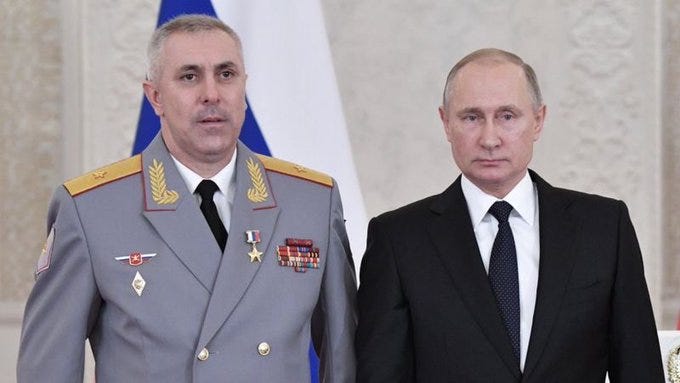

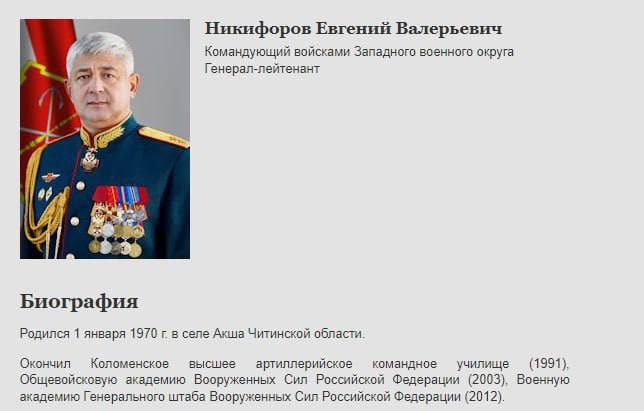
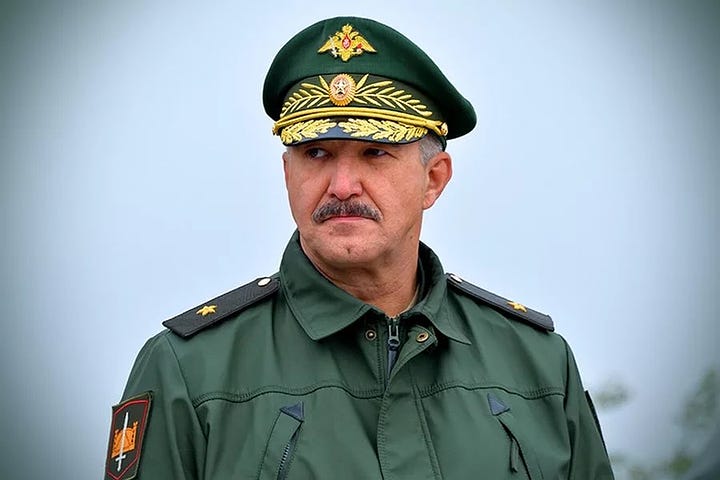
Many might argue that replacing a bunch of your top commanders literally on the eve of your greatest battle is a horrible tactic smacking of ‘Stalin’s purges’ on the eve of WW2. But contrary to what Ukro-propagandists are saying regarding Muradov et al (“he got the Russian Marines killed!”), these appointments are more a ‘reshuffling’, as some of these generals were already commanding a military district but got swapped, others were merely promoted in rank. And also, these actions have more the character of promotions of commanders who proved themselves most capable in actual battle so far, rather than being ‘purged for ideological reasons’ like Stalin is claimed to have done.
In short, Putin is maneuvering the most combat capable commanders into their ideal positions on the eve of major operations.
The only question remains what kind of ‘opening’ might we expect to the new phase. Would it be a massive ‘shock and awe’ following a doctrinal shift (as hinted in some of the posts above), where Russia would begin fighting the conflict more as a ‘war’ rather than a ‘special military operation’? Most of us are understandably skeptical of such a thing, despite our outlining in the last report how Russia has appeared to slowly be sliding in that direction, what with the attacks on Odessa bridge and the beginning of targeting actual turbines and engine rooms of the thermal plants, rather than substations/transformers.
For a long time there were rumors of Iranian shipments of medium range ballistic missiles. Many wondered why Russia hasn’t used them yet despite some western intel ‘confirmation’ that they did in fact receive them. My openly stated possibility from many months ago was that IF they really did receive such missiles, they would likely be saving them for a large ‘shock and awe’ opening campaign to the long anticipated next phase of operations.
So that remains one possibility. Russia could choose to open up the offensive with large disabling strikes on the Dnieper bridges, as we outlined in Part 2. However, I do still lean towards the more probable saving of the bridges until later, when enough UA reserves have poured into the Donbass region—it would make more sense to disable the bridges then, if you’re going to do it at all (also all outlined in Part 2).
But the more likely method remains a slow-rolled and ‘staggered’ offensive, which we also talked about last time. This is where each new front/vector would be activated at a time, in order to let UA pour reserves there, and take them away from other key regions, then invade the remaining now-depleted region.
The most likely starting vector is looking more and more like Zaporozhe simply because the most confirmed activity is being seen in the sector involving Mariupol toward Kherson. The reason is because it’s the most critical. On one hand, I outlined in part 2 how Putin’s constitutional decrees/obligations mean that Kharkov and the remainder of Lugansk would need to be taken with utmost priority. HOWEVER, the breaking of AFU lines in Zaporozhe has even higher priority than that due to the fact that this is where Russia’s weakest point remains, owing to the vulnerability of Crimea.
It’s an open secret UA intends to build for a mass Spring offensive in the direction of Zaporozhe in order to sever the Crimean landbridge, which would come with simultaneously coordinated attempts to sever the Kerch bridge (whether terror actions or newly received GLSDB’s, ATACMs, etc.). This would catastrophically cut Crimea off, and so even the (unlikely) prospect of such an event means Russia needs to establish initiative here with utmost authority and priority, and basically ‘break the AFU’s back’ in this region.
Thus I suspect they will likely strike here first and begin pushing UA back toward Zaporozhe city. We’ve already reported last time that—foreseeing this—Ukrainian authorities have already begun fortifying the center of Zaporozhe city, as they know combat is coming to it very soon.
After that, in staggered fashion, once UA has desperately sent reserves to reinfroce the Zaporozhe line, another large Russian force could likely move into either Kharkov or Sumy/Chernigov regions, or maybe all of those northern regions at the same time.
This is how we’re seeing it so far, but it could change. And there’s also good reason to believe that Russia may in fact be playing it by ear to the extent that, in modern warfare, you can’t set concrete plans and put all your eggs in one basket. As we mentioned in the ISR article, there are way too many variables in how your enemy can expose your movements, and as such, it’s best to draw up very fluid/variable/modular plans whose pieces can be modified at any given time to thwart the ISR overreach of your opponent. Not to mention this is all part of basic maskirovka 101.
Hence, I suspect Russia has its main vectors/objectives set in a fluid Jeet Kune Do fashion, such that they can be swapped momentarily.
So we’ll see in the next few days if any new big updates give us further insight and clarity.
And remember what Putin said last year regarding what’s yet to come:


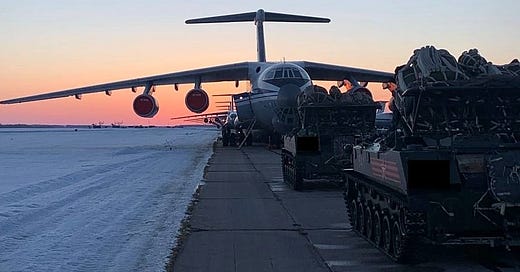




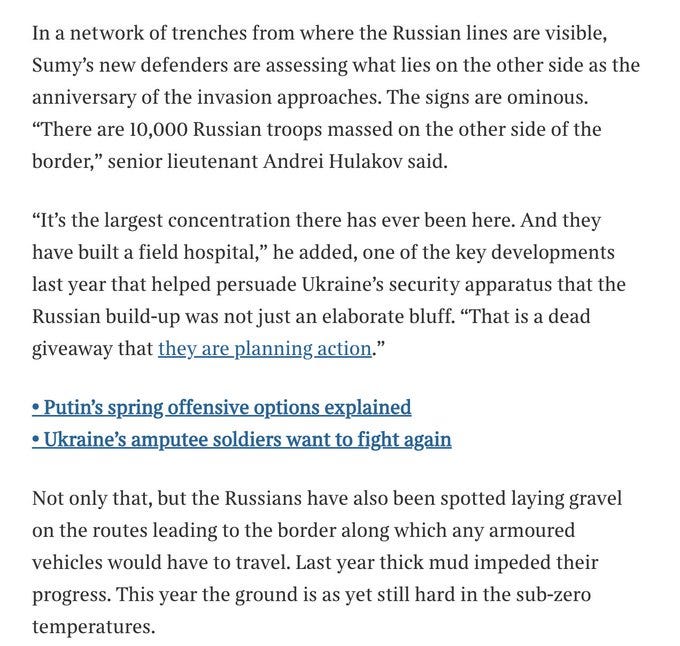

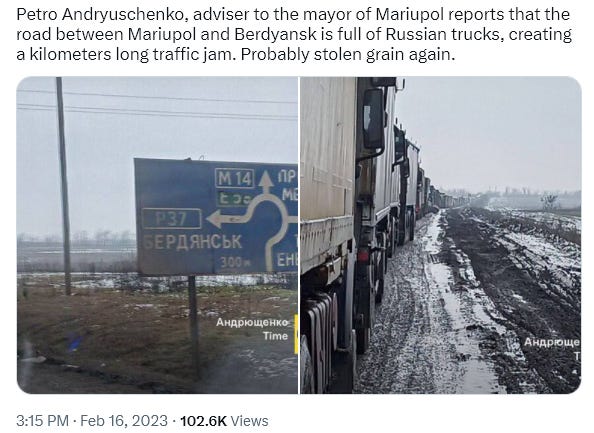


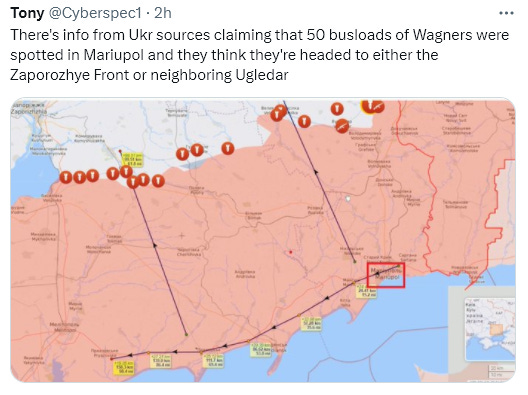


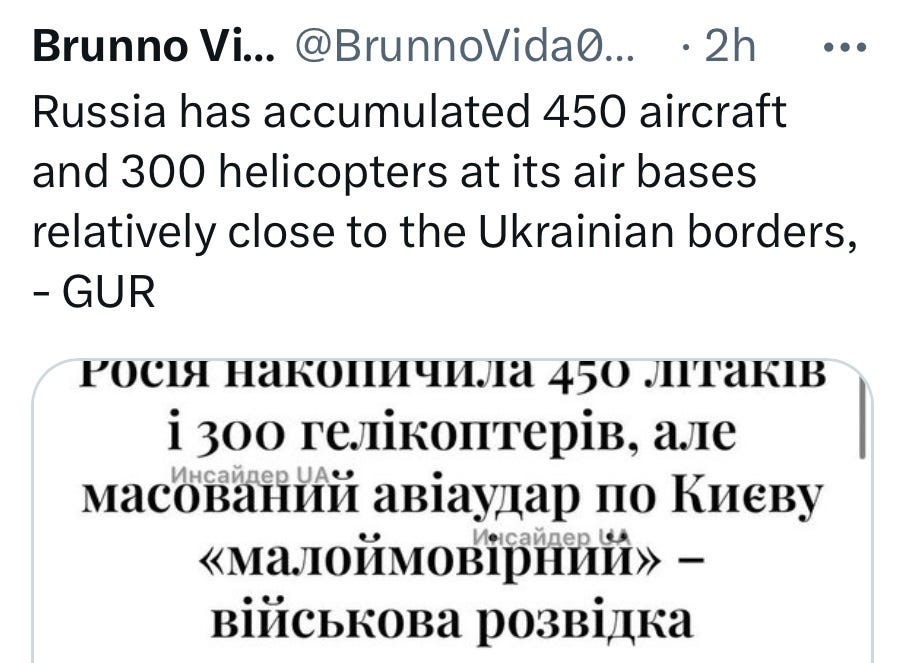







Lol, twitter cope is great, its why i get banned so much. Those trucks cant carry any grain unless someone shovels it into sacks. People are so dumb.
Whatever happens it wont be what we expected, i learned that in 2014.
In this day and age i would have trucks trucking everywhere BUT where i was really going. Same with the field hospitals, you can wait until it starts before putting one of those up if you want, probably takes 2 hrs with enough guys and a plan. And Russians can drill better than anyone.
The one thing i would do is eliminate all the reasons the us wants ukraine, destroy cargils elevators, destroy everything monsanto owns etc.
"Note, the specific confirmation of something we predicted here in one of the recent reports, which is that the offensive is likely to kick off, not all at once but in several stages in order to maximize confusion, allow a little lead time for AFU to frantically send reserves to one direction to caulk the flow, only for a completely different direction to massively kick off into un-reinforced territory."
I would argue that this has already been going on for a while now. Russia has been attacking at points all along the front, except for Kherson. This has drawn off many Ukrainian reserve brigades, two for Ugledar alone, for example.
What I find interesting is that where the Russian met only light resistance, from weak territorial formations or heavily depleted regular infantry brigades, they kept pushing. But they stopped, or even fell back, when faced with more capable resistance, which usually came from hastily brought in Ukrainian reserves. That very strongly suggests that along most of the front at least, the primary objective for these Russian attacks were not specific geographical locations (Ugledar, Marinka, Kupyansk, etc), but to force the Ukrainians into spending their reserves.
And if Russia were to launch a major offensive soon, a smart general would, if he had the opportunity to do so, start with some preliminary 'faints' which would force the Ukrainians to spend their reserves prematurely, or lose those important locations. It's not proof of an imminent offensive though, as the greater Russian objective with these 'faints' may simply have been to draw these Ukrainian reserve formations into artillery range, and do some more 'demilitarising'. Or, as we talked about earlier, going from 'death by a thousand paper cuts', to 'death by a hundred knife cuts'.
But it doesn't contradict the possibility of an imminent offensive either. Nevertheless, I'm still hesitant about any single 'big arrow' offensive setting off soon, along just one front sector. Major attacks along a number of different axis in different places seems more likely to me.